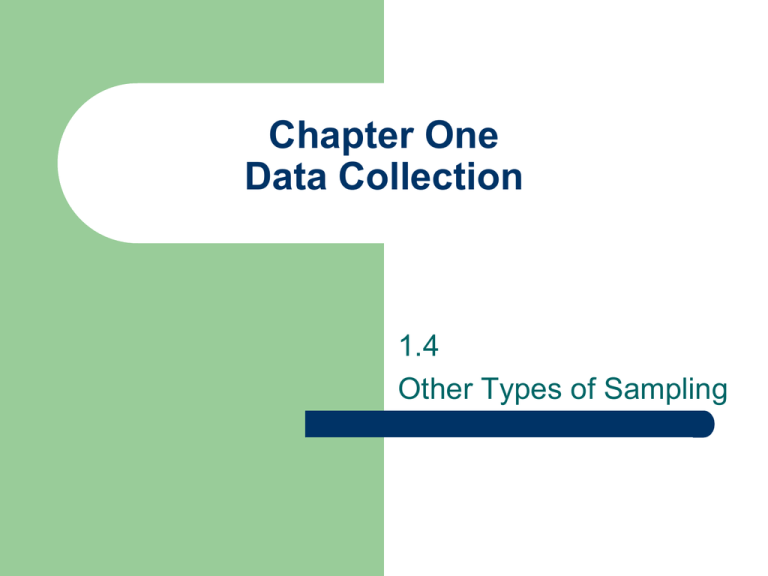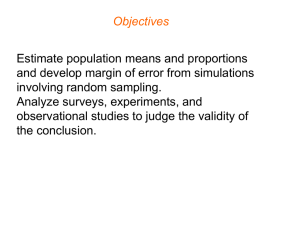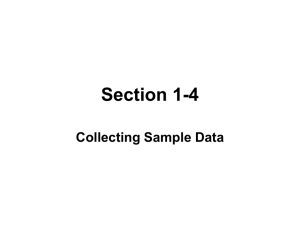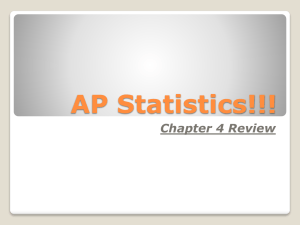File
advertisement

Chapter One Data Collection 1.4 Other Types of Sampling Objective(s) Obtain a stratified sample. Obtain a systematic sample. Obtain a cluster sample. Warm-up Explain in your own words what a simple random sample is. Give one pro and one con of using a simple random sample. Simple Random Sampling Pros: Almost Easiest Requires little knowledge of pop Cons: Possibly larger sampling error [more variation] from sample to sample Need to have a listing of population elements in some form Definition A stratified sample is one obtained by separating the population into homogeneous, non-overlapping groups called strata, and then obtaining a simple random sample from each stratum. Stratified Sampling EXAMPLE Obtaining a Stratified Sample The 107th Congress of the United States (2001 - 2003) had 435 members in the House of Representatives (221 Republicans, 212 Democrats, and 2 Others). The president wants to have a luncheon with 4 Republicans, 4 Democrats and 1 Other. Obtain a stratified sample in order to select members who will attend the luncheon. Stratified Random Sample Pros: Less sampling error [variability from sample to sample] Able to analyze more about groups with small proportions in the population Cons: For each element you need to have a list of characteristics for which you want to stratify May cost more and not be worth it…just take a larger SRS Definition A systematic sample is obtained by selecting every kth individual from the population. The first individual selected is a random number between 1 and k. Systematic Sampling EXAMPLE Obtaining a Systematic Sample A quality control engineer wants to obtain a systematic sample of 25 bottles coming off a filling machine to verify the machine is working properly. Design a sampling technique that can be used to obtain a sample of 25 bottles. STEPS IN SYSTEMATIC SAMPLING, POPULATION SIZE KNOWN Step 1: Determine the population size, N. Step 2: Determine the sample size desired, n. Step 3: Compute N/n and round down to the nearest integer. This value is k. Step 4: Randomly select a number between 1 and k. Call this number p. Step 5: The sample will consist of the following individuals: p, p + k, p + 2k,…, p + (n – 1)k Systematic Random Sampling Pros Easiest Cons Possible periodicity Need a list or mapping of population Definition A cluster sample is obtained by selecting all individuals within a randomly selected collection or group of individuals. Useful when a sampling frame (a list) of elements is not available like with large populations that are spread out across a wide geographic area or across many different organizations Cluster Sampling EXAMPLE Obtaining a Cluster Sample A school administrator wants to obtain a sample of students in order to conduct a survey. She randomly selects 10 classes and administers the survey to all the students in the class. EXAMPLE Obtaining a Cluster Sample You want to conduct face-to-face interviews with people. To save on travel expenses, you may consider “clusters” of neighborhoods or city blocks. Cluster samples often involve multiple stages, with clusters within clusters, as when a national study of middle school students might involve first sampling states, then counties, then schools, and finally students within each selected school . Cluster Sampling Pros Saves time Saves money Should allow for closer supervision in the field Requires enumerating only part of the population Cons Larger sampling error [variation in score form sample to sample] Typically “requires” larger sample Definition A convenience sample is one in which the individuals in the sample are easily obtained. Definition A convenience sample is one in which the individuals in the sample are easily obtained. Any studies that use this type of sampling generally have results that are suspect. Results should be looked upon with extreme skepticism. EXAMPLE •Interviewing people on a •Magazine surveys street corner or at the •Observing conversations mall in an on-line chat room •Surveying students in a classroom Convenience Sampling a.k.a. Availability sampling Pros Easiest Cons Least information Objective(s) Obtain a stratified sample. Obtain a systematic sample. Obtain a cluster sample. To estimate the percentage of defects in a recent manufacturing batch, a qualitycontrol manager at Intel selects every 8th chip that comes off the assembly line starting with the 3rd until she obtains a sample of 140 chips 1. 2. 3. 4. Simple Random Sample Stratified Sample Systematic Sample Cluster Sample 25% 25% 25% 25% To determine the prevalence of human growth hormone (HGH) use among high school varsity baseball players, the State Athletic Commission randomly selects 50 high schools. All member of the selected high schools’ varsity baseball teams are tested for HGH 1. 2. 3. 4. Simple Random Sample Stratified Sample Systematic Sample Cluster Sample 25% 25% 25% 25% To determine customer opinion of its boarding policy, Southwest Airlines randomly selects 60 flights during a certain week and surveys all passengers on the flights 1. 2. 3. 4. Simple Random Sample Stratified Sample Systematic Sample Cluster Sample 25% 25% 25% 25% A member of Congress wishes to determine her constituency’s opinion regarding estate taxes. She divides her constituency into three income classes: low-income households, middleincome households, and upper-income households. She then takes a simple random sample of households from each income class. 1. 2. 3. 4. Simple Random Sample Stratified Sample Systematic Sample Cluster Sample 25% 25% 25% 25% In an effort to identify if an advertising campaign has been effective, a marketing firm conducts a nationwide poll by randomly selecting individuals form a list of known users of the product. 1. 2. 3. 4. Simple Random Sample Stratified Sample Systematic Sample Cluster Sample 25% 25% 25% 25% A radio station asks its listeners to call in their opinion regarding the use of U.S. forces in peacekeeping missions. 1. 2. 3. 4. Simple Random Sample Stratified Sample Systematic Sample Cluster Sample 25% 25% 25% 25% A farmer divides his orchard into 50 subsections, randomly selects 4, and samples all the trees within the 4 subsections to approximate the yield of his orchard. 1. 2. 3. 4. Simple Random Sample Stratified Sample Systematic Sample Cluster Sample 25% 25% 25% 25% A school official divides the student population into five classes: freshman, sophomores, junior, senior, and graduate student. The official takes a simple random sample from each class and asks the members’ opinions regarding student services 1. 2. 3. 4. Simple Random Sample Stratified Sample Systematic Sample Cluster Sample 25% 25% 25% 25% A survey regarding download time on a certain website is administered on the Internet by a market research firm to anyone who would like to take it 1. 2. 3. 4. Simple Random Sample Stratified Sample Systematic Sample Cluster Sample 25% 25% 25% 25% The presider of a guest-lecturer series at a university stands outside the auditorium before a lecture begins and hands every fifty person who arrives, beginning with the third, a speaker evaluation survey to be completed and returned at the end of the program 1. 2. 3. 4. Simple Random Sample Stratified Sample Systematic Sample Cluster Sample 25% 25% 25% 25% To determine his DSL internet connection speed, Shawn divides up the day into foru parts: morning, midday, evening, and late night. He then measures his internet connection speed at 5 randomly selected times during each part of the day. 1. 2. 3. 4. Simple Random Sample Stratified Sample Systematic Sample Cluster Sample 25% 25% 25% 25% 24 Hour Fitness wants to administer a satisfaction survey to its current members. Using its membership roster, the club randomly selects 40 club members and asks them about their level of satisfaction with the club 1. 2. 3. 4. Simple Random Sample Stratified Sample Systematic Sample Cluster Sample 25% 25% 25% 25%










